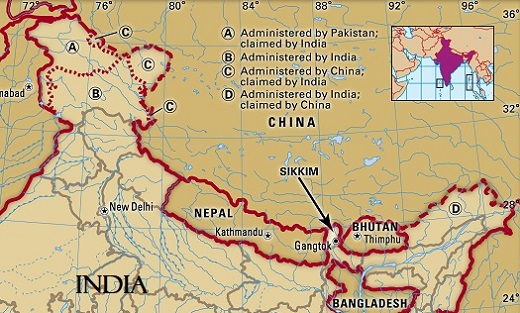Why in news?
The Prime Minister greeted the people of Sikkim on their Statehood Day on May 16th.
On 16 May, 1975, the Himalayan Kingdom of Sikkim became the 22nd state of India, and putting an end to the monarchy.
Sikkim’s Statehood: History
- In the 1640s India, Pakistan Bangladesh and Nepal were still many princely states with many rulers at that time and had not unified.
But by this time, Sikkim had already solidified into country then with a king known as a Chogyal or dharma king, and till 16 May 1975 was an independent country ruled by the monarchs. - In the early 18th century, the British Empire sought to establish trade routes with Tibet, leading Sikkim to fall under British suzerainty until independence in 1947. The Treaty of Tumlong in 1861 made Sikkim a protectorate of the British.
- Initially, Sikkim remained an independent country, until it merged with India in 1975 after a decisive referendum.
- Indian independence and its move to democracy spurred a fledgling political movement in Sikkim, giving rise to the formation of Sikkim State Congress (SSC).
- After India’s independence in 1947, the guarantees of independence that Sikkim had acquired from the British were transferred to the new Indian government.
- In 1950, a treaty was agreed between India and Sikkim which gave Sikkim the status of an Indian protectorate.
- The then Prime Minister Jawaharlal Nehru gave special protectorate status for Sikkim, which was to be a ‘tributary’ of India.
- Sikkim came under the suzerainty of India, which controlled its external affairs, defence, diplomacy and communications.
- In 1973, anti-royalist riots took place in front of the Chogyal’s palace.
- In 1975, the Prime Minister of Sikkim appealed to the Indian Parliament for Sikkim to become a state of India. In April 1975, the Indian Army took over the city of Gangtok and disarmed the Chogyal’s palace guards.
- Thereafter, a referendum was held for abolishing the monarchy, effectively approving union with India.
- On 16 May 1975, Sikkim became the 22nd state of the Indian Union, and the monarchy was abolished.
- To enable the incorporation of the new state, the Indian Parliament amended the Indian Constitution. First, the 35th Amendment laid down a set of conditions that made Sikkim an “Associate State”, a special designation not used by any other state.
- The 36th Amendment repealed the 35th Amendment, and made Sikkim a full state, adding its name to the First Schedule of the Constitution.

Creation of New States in Indian Constitution
The procedure for formation of new States laid down in Article 3 of the Constitution.
Article 3 assigns to Parliament the power to enact legislation for the formation of new States. Parliament may create new States in a number of ways, namely by:
- separating territory from any State
- uniting two or more States
- uniting parts of States
- uniting any territory to a part of any State
Parliament’s power under Article 3 extends to increasing or diminishing the area of any State and altering the boundaries or name of any State.
Note: A state has no say over the formation of new States beyond communicating its views to Parliament.
- A bill calling for formation of new States may be introduced in either House of Parliament only on the recommendation of the President.
- The bill must be referred by the President to the concerned State Legislature for expressing its views to Parliament if it contains provisions which affect the areas, boundaries or name of that State.




